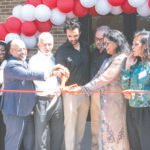In Your Opinion: Compressor Station And Pipeline Will Cost Well Into The Future
Submitted by Franklin Township Task Force on Compressor Station 206 & NESE’s Steering Committee.
Series Issue 6: Williams-Transco’s NESE and Compressor Station 206: Who Will Protect Us?
The costs of continuing to build natural gas facilities and pipelines will be borne by all of us and future generations who will contend with health issues, impacts from severe weather events, potential lessening of property values, and other inherent dangers from air and water pollution that result from natural gas pipelines and compressor stations.
Remember the effects of Superstorm Sandy? In addition to the devastation experienced by folks in New Jersey from that, Sandy cost the Federal government over $50 billion (1), and insurance companies paid another $18.75 billion for damages from Sandy for 1.58 million claims. (2)
Think of the wildfires in California now and the droughts in the Midwest.
There are alternatives to using fossil fuel, and where there’s a will, there’s a way. It is up to us to speak out to our elected officials, the Federal Energy Regulatory Commission (FERC), and the New Jersey Department of Environmental Protection (NJDEP) to hold them responsible for protecting our health, safety, wildlife, vegetation, trees, air, and water. We need to act so that we do not need to adapt to these risks.
The public is not protected when:
1. Climate change science is downplayed, and resulting explosions, fires, landslides, etc. at natural gas facilities and pipelines could have been avoided.
2. Additional pollution-generating facilities are approved when we already live in an ozone-compromised region, and many counties in NJ received grades of “F” for air quality.
3. No local, state or federal agency takes the responsibility to ensure that a comprehensive Health Impact Assessment is conducted in the area around parts of natural gas exploration, extraction, processing, transmission or compression.
4. Methane leaks (the primary component of natural gas) are not accurately measured, monitored or quickly fixed, and the danger from this flammable chemical is also seen in its contribution to greenhouse gas that is associated with costs from severe weather events that are increasing in frequency and intensity (floods, severe rains, wildfires, droughts & sea-level rise).
5. Human error, poor procedures, or not following procedures when operating a natural gas facility results in explosions, fires, deaths, injuries, and property damage or destruction.
6. Inspection and repair of pipelines do not account for the potential for the rate of pipeline corrosion to increase more quickly than anticipated, possibly due to increased compression, which causes a pipeline to explode before the next scheduled inspection.
7. The agency responsible for determining if a proposed natural gas project can be built and operated safely without significant impacts on the environment, wildlife or people (FERC), bases decisions on incomplete and misleading information without appropriately completing independent studies and considering input of the public.
8. The agency responsible for issuing a certificate of “public convenience and necessity” (FERC) has no jurisdiction over the source of the natural gas (i.e., fracked gas from the Marcellus Shale region in Pennsylvania) or the end use of the gas by the customer who committed to buying it from the company constructing the pipeline.
9. The agency in NJ responsible for determining if a proposed project meets air and water quality standards (NJDEP) issued an Air Pollution Permit for the NESE Project in September 2017 and then, in early 2018, revised the levels of air pollutants that are deemed to protect us to be much more stringent. Even though the NESE Project’s anticipated emissions exceed these new levels, the issued permit remains in effect since it was granted under the older standards which are now considered to be harmful.
10. The agency responsible for ensuring that natural gas pipelines and facilities are operating safely (PHMSA) is understaffed.
11. There is a rush to construct more pipelines to transport fracked gas to customers, some of which might be planning to export it, and the rate of damaging incidents for pipelines constructed in the 2010’s is higher than those for pipelines constructed as far back as 1940.
12. FERC guarantees pipeline companies and their financial backers a 14% minimum rate of return on their investment.
13. Natural gas pipeline companies solicit cooperative and friendly relationships with local groups by financing projects of interest in the areas of pipelines and compressor stations.
14. Elected legislators make decisions based on the influence of money from billionaires or businesses that could impact their chances for reelection.
15. Billions of dollars in subsidies and tax breaks are provided to the fossil fuel industry each year.
The costs of continuing polluting use of fossil fuels and doing what needs to be done to protect our futures was noted in a message that President Johnson sent to Congress over 50 years ago. Sadly, the costs of inaction have been mounting, but the current costs of using renewables and increasing energy efficiency are not as expensive as they were in the 1960’s. LBJ wrote:
We are able to see the magnitude of the choice before us, and its consequences for every child born on our continent from this day forward. Economists estimate that this generation has already suffered losses from pollution that run into billions of dollars each year. But the ultimate cost of pollution is incalculable. We see that we can corrupt and destroy our lands, our rivers, our forests, and the atmosphere itself all in the name of progress and necessity. Such a course leads to a barren America, bereft of its beauty, and shorn of its sustenance. We see that there is another course more expensive today, more demanding. Down this course lies a natural America restored to her people. The promise is clear rivers, tall forests, and clean air – a sane environment for man.
– “Preserving Our Natural Heritage,” Message from the President of the United States, transmitting “Programs for Controlling Pollution and Preserving our Natural and Historical Heritage,” February 23, 1966.
During the past week, you’ve been provided with a series of informational pieces about the risks to our health, safety, wildlife, vegetation, trees, air, and water from the proposed Northeast Supply Enhancement (NESE) Project and Compressor Station 206. Items in this list above were elaborated in those pieces, and more information is available on our website, www.scrap-NESE.org
With opposition to the NESE Project, we join others in an effort to have the costs to society and the environment be considered as more important than the profits to fossil fuel industry businesses. If NESE’s Compressor Station 206 and pipeline in & by the Raritan Bay are constructed, we and future generations will be subjected to risks from air and water pollution, potential explosions, and extreme weather events. We believe that exposure to pollutants, carcinogens and poisons, and safety risks for the profits of the fossil fuel industry should not be acceptable.
- The U.S. Constitution recognizes and preserves our right to be free from government actions that harm life, liberty and property. These rights belong to present & future generations
- The Public Trust Doctrine requires our state government to safeguard the long-term preservation of natural resources, such as air, water and land, for the benefit of current and future generations.
As said earlier, there are energy alternatives, and these create good jobs along with cleaner air and water. These alternatives are less expensive than continued reliance on natural gas. Now is NOT the time to continue approving fossil fuel projects like the Northeast Supply Enhancement Project.
Now is NOT the time to keep quiet!
We must continue to support strong actions, public policies and smart growth that will reduce the risks of air pollution to keep our local air and water clean. All voices count, and the outcry needs to maintain momentum! Now is the time to make a difference by calling, writing and using social media to oppose this poisonous Project because FERC anticipates publishing their Final Environmental Impact Statement in September 2018. After that, our comments will not be considered by them.
What can you do?
Tell the NJDEP that you want them to (1) hold public hearings (“fact-finding meetings”) and (2) deny the new water permit applications for the NESE Project.
You can sign the online petition letter to NJDEP provided by Food & Water Watch by going to:
https://secure.foodandwaterwatch.org/act/stop-transco-pipeline-and-compressor-station
See the attached letter, add your personal information at the end, and send it, along with any written comments, to the NJDEP people listed below. You can either email it by August 3 or mail the completed letter by August 1.
Send emails of letters to:
Commissioner@dep.nj.gov
Ruth.Foster@dep.nj.gov
Matthew.Resnick@dep.nj.gov
Christopher.Jones@dep.nj.gov
Mail letters to:
Catherine R. McCabe, Commissioner & Ruth W. Foster, PhD., P.G., Acting Director (addresses are on the letter)
And send copies to:
Bureau of Urban Growth & Redevelopment – Division of Land Use Regulation
501 East State Street, 2nd Floor
PO Box 420 – Mail Code 501-02A
Trenton, NJ 08625-0420
Attn.: Matthew Resnick & Christopher Jones
Other actions that can help:
Tell your State Representatives to support Joe Danielsen’s Resolution AR164, and encourage your State Senators to do a companion resolution opposing the NESE Project. See attachment.
Tell your local, state and federal officials about your concerns with the NESE Project and ask them to act to protect you.
Write comments to FERC about your concerns.
Go to www.scrap-NESE.org for information about the NESE Project, sample comments, the letter to NJDEP, and actions to take.
(1) “Potential Increases in Hurricane Damage in the United States: Implications for the Federal Budget,” Congressional Budget Office (CBO), p. 17, https://www.cbo.gov/sites/default/files/114th-congress-2015-2016/reports/51518-hurricane-damage.pdf.
(2) “Catastrophes: U.S.,” Insurance Information Institute, http://www.iii.org/fact-statistic/catastrophes-us. “Potential Increases in Hurricane Damage in the United States: Implications for the Federal Budget”, Congressional Budget Office (CBO), June 2016, https://www.cbo.gov/sites/default/files/114thcongress-2015-2016/reports/51518-hurricane-damage.pdf.























































